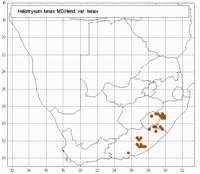Common names:
Klewerig reusesewejaartjie (A), Sticky everlasting
Origin of name:
tenax = strong, tough; holding fast
Diagnostic characters:
Rosette with large basal leavesBright yellow bractsLarge solitary heads in open branched inflorescence
Description:
Bushy subshrub up to c. 1.8 m high, viscid and aromatic particularly when fresh, stem base thick and woody, branching (and sometimes rooting) there or higher, branches spreading, rough with leaf bases, glandular and with traces of white wool, each terminating in a large leaf rosette subtended by dry withered leaves, flowering stems (peduncles) one or several from the axils of the spent leaves below the fresh terminal growth, c. 300 (�450) mm long, glandular, thinly to thickly appressed white-woolly as well, closely leafy. Rosette leaves up to c. 180 (�250) x 80 mm, narrowly to broadly elliptic or obovate, narrowed to a broad clasping base, apex acute to obtuse, apiculate, margins of young leaves often undulate, both surfaces very glandular, in var. pallidum greyish woolly as well, at least below; peduncle leaves erect, imbricate, up to 80 x 20 (�30) mm, diminishing in size upwards, oblong-lanceolate to lanceolate, apex subacute to acute to acuminate, apiculate, base broad, cordate-clasping, sometimes very shortly decurrent, margins crisped-undulate in upper half, both surfaces glandular-pilose with traces of white wool on the margins and over the main veins to densely greyish-white woolly in var. pallidum. Heads heterogamous, depressed-globose, c. 25�35 mm across the radiating involucral bracts, solitary or up to c. 12 in a compact corymbose cluster at the peduncle tip, loosely white-woolly at the base. Involucral bracts in 10 series, somewhat graded, imbricate, much exceeding the flowers, radiating, acute, glossy, bright or pale yellow, or creamy white overlaid palest buff in var. pallidum. Receptacle shortly honeycombed. Flowers 701�1148, 80�156 female, 592�1048 homogamous, yellow. Achenes 0.75�1 mm long, barrel-shaped, glabrous. Pappus bristles many, equaling corolla, tips barbellate, bases cohering lightly by patent cilia.
Flowers between October and December.
Distribution:
Grows on grassy mountain slopes particularly near rocks, or in the boulder beds of mountain streams, and readily becomes a weed colonizing bare or disturbed areas. Ranges from the mountainous northern part of Lesotho along the face of the KwaZulu-Natal Drakensberg and its outliers (including the Karkloof range) to the mountains about Kokstad and the face of the Drakensberg in the Transkei to the mountainous parts of the Eastern Cape as far west as the Wildschutsberg near Molteno, Katberg, and the Suurberg N. of Port Elizabeth.
Grassland Biome.
Notes:
Two varieties are recognized:
Involucral bracts yellow; leaves without white wool except sometimes on the margins and over the veins
(a) var. tenax
Involucral bracts creamy-white, outer overlaid palest buff; leaves greyish-white at least on lower surface
(b) var. pallidum
At Katberg and Hogsback, the rosette leaves are much narrower than in specimens from further north, and the heads are often solitary. However, these rosettes of very sticky leaves are diagnostic. But even detached flowering stems are easily recognized by the loose white wool on the stem and enveloping the base of each head, and the crisped-undulate leaf margins.
Taxonomy:
Literature:
Helichrysum tenax M.D. Henderson in Bothalia 6: 423 (1954); Hilliard Compositae in Natal 248 (1977).
Type:
KwaZulu-Natal, Bergville distr., Cathedral Peak Forest Research Station, 5 800 ft, Killick 1632 (PRE, holo.; K; NH; NU, iso.).
Synonym(s):
H. fulgidum (L.f.) Willd. var. subnudatum DC., Prodr. 6: 187 (1838). Type: Cape, Zwart Kei, in the Mountains, Dr�ge 5733 (G-DC, holo.).
Vouchers:
Acocks 9316 (PRE); Barker 1161 (NBG); Hilliard & Burtt 7369 (E; K; MO; NU; S); Hilliard & Burtt 11031 (E; K; NU; S); Wright 356 (E; NH; NU).
